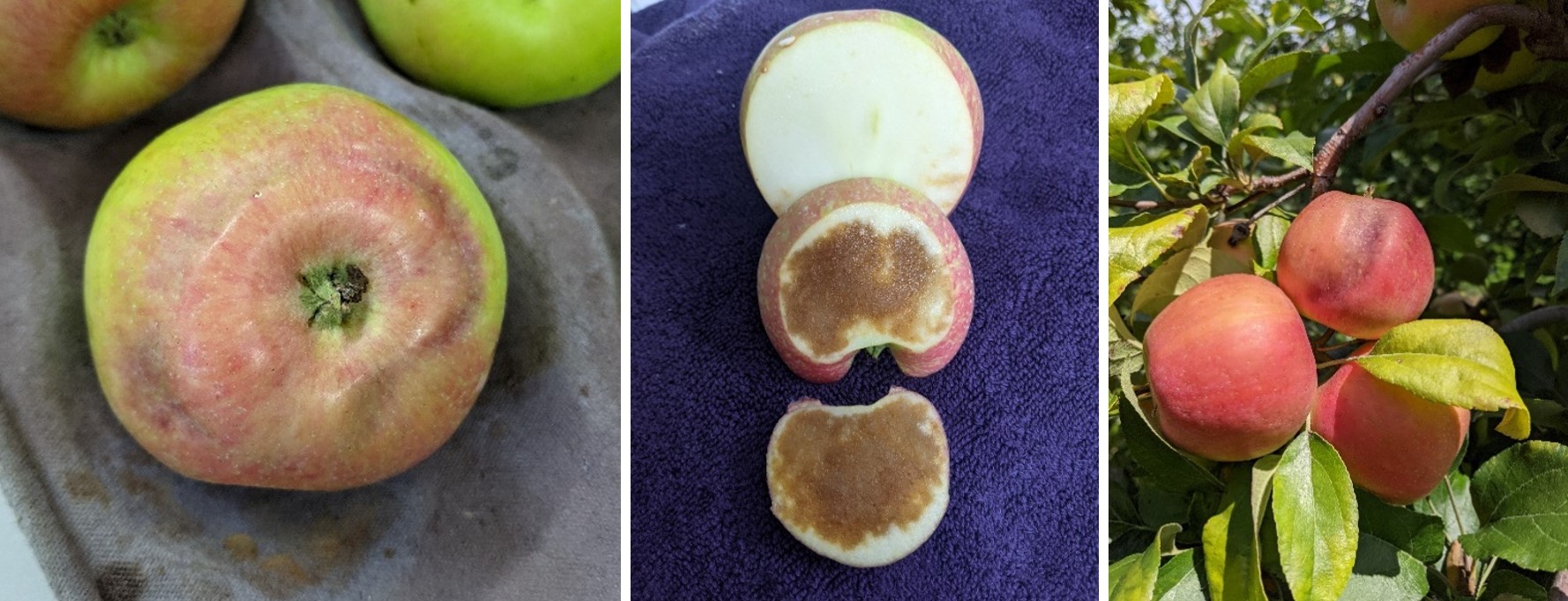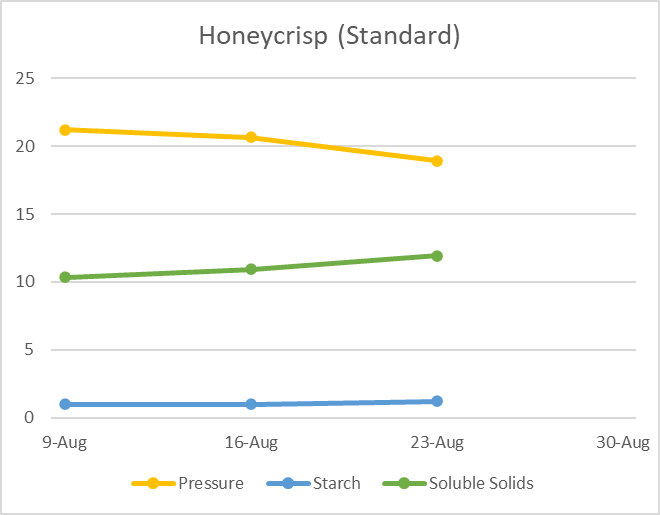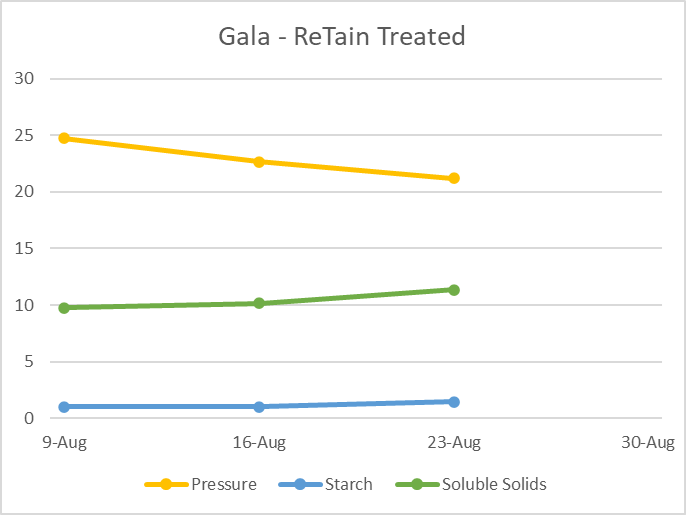Grand Rapids area apple maturity report – Aug. 25, 2021
This is the third apple maturity report for the 2021 harvest season.

This is the third apple maturity report for the 2021 harvest season. Reports are sent out every week (usually on Wednesdays), following the Michigan State University Extension fruit team apple maturity calls on Wednesday morning.
For general information about how samples are collected and processed, please refer to Apple Maturity Report #1.
- Considerations for the 2021 harvest season can be found in this article.
- More information on harvest management tools and timings can be found in this article.
- Guidelines from MSU to check for apple maturity in your own orchard, including specific pressure and starch recommendations by variety.
- Predicting apple maturity and starch chart from Cornell University
- Starch chart for Honeycrisp Apples developed by Washington State University.
How to read the maturity tables
For each variety evaluated, we provide data from our evaluations in a table. In each table, a row is provided for each sample tested. This allows you to see how the varieties may be progressing in different regions or specific locations. An average is included for each variety. Maximum and minimum values are included for the highest and lowest individual fruits evaluated for each, to give a full spectrum of the maturity. Recommended values are included for each variety at the bottom of the table. These suggested values for firmness and starch index were also published in a standalone table format. Firmness ranges encompass long and short-term storage recommendations.
Updates for this week
- Weather: The remainder of August is expected to be warmer and drier than normal. This week, expect highs in the mid to upper-80s degrees Fahrenheit and lows in the mid-60s, and very humid conditions. This will have an impact on drop-susceptible fruit and stop-drop materials. In general, we need a few cooler nights for better color development and a little more precipitation (or continued irrigation) to help with fruit size. There is a good chance of precipitation each day this week.
- Ginger Gold and Zestar: These early varieties are finished or nearly finished harvest. Maturity metrics (starch, firmness, soluble solids) indicate that some fruit is ripe, although there is a range of maturity on the tree (as is typical of these varieties). In these varieties, look for a change in background color from green to green/yellow and development of varietal flavor.
- Paula Red is beginning harvest.
- Wildfire Gala is harvesting now. Standard strains (Buckeye, Brookfield) still need time.
- Premier Honeycrisp is harvesting now. Standard strains are still approximately two to three weeks away from harvest.
- McIntosh (Ruby Mac) is beginning to show signs of maturity, but harvest is a couple of weeks away.
- Predicted harvest dates according to the Maturity Model in Enviroweather are about 10 days earlier than normal for early varieties (Gala, Honeycrisp, McIntosh), making this week about 21 days before harvest for Honeycrisp and Gala. At this time, we believe this will be fairly accurate.
- Mixed maturity is evident in most varieties and locations. Multiple picks may be needed to harvest fruit at the appropriate maturity for successful storage conditions.
- Some frost damage is evident in locations in the form of russeting, frost rings and misshapen fruit.
Ruby Mac
Two samples were taken this week for evaluation. There are some signs of fruit beginning to mature. It will likely be a couple more weeks until earlier McIntosh strains will begin harvest. Very nice color development on most fruit, but still very firm, low sugars (soluble solids/Brix). Some starch clearing has just started.
|
Variety |
Location |
Fruit Weight (g) |
Ethylene (% >0.2ppm) |
Red Color (%) |
Background color (5-1) |
Firmness (lbs) |
Starch (1-7) |
Soluble Solids (°Brix) |
|
Ruby Mac |
Ridge3 |
120 |
0% |
36.0 |
5.0 |
17.9 |
2.5 |
11.3 |
|
Ruby Mac |
Ridge4 |
140 |
20% |
35.0 |
5.0 |
17.0 |
2.5 |
10.2 |
|
Average |
|
130 |
10% |
35.5 |
5.0 |
17.5 |
2.5 |
10.8 |
|
Max |
|
|
20% |
50.0 |
5.0 |
22.1 |
3.0 |
11.3 |
|
Min |
|
|
0% |
20.0 |
5.0 |
14.6 |
2.0 |
10.2 |
|
Recommended |
|
|
|
|
|
14-16 |
5-7 |
|
|
Collection Date |
Fruit Weight (g) |
Ethylene (% >0.2ppm) |
Red Color (%) |
Background color (5-1) |
Firmness (lbs) |
Starch (1-6) |
Soluble Solids (°Brix) |
|
9-Aug |
115 |
NT |
78.7 (75.5-84.0) |
5 |
18.4 (18.9-17.9) |
2.2 (2.0-2.4) |
10.2 |
|
16-Aug |
130 |
NT |
76.0 (50.0-90.0) |
5 |
17.3 (15.0-20.3) |
3.0 (2.0-4.0) |
10.3 |
|
23-Aug |
130 |
10% (0-20%) |
35.5 (20.0-50.0) |
5 |
17.5 (14.6-22.1) |
2.5 (2.0-3.0) |
10.8 |
Honeycrisp
Premier Honeycrisp is beginning harvest now. As expected, there is a very broad range of maturity within blocks and trees.
Standard Honeycrisp harvest is still approximately two to three weeks until harvest. All fruit tested were very starchy, low in sugar content, and had high firmness. Minimal color development was observed in almost all locations—only a handful of fruit have begun to start some red color development and background color is still very green. Starch in this variety shows a considerably different pattern than other varieties. Refer to this starch chart (which uses a 1-6 scale and unique staining pattern) for maturity evaluation.
Some fruit is already very large in size, although highly dependent on crop load, which is considerably variable this season. Some frost damage is apparent in the form of russetting or other damage to fruit finish. In addition, sunburn was detected in two blocks in the form of necrotic, depressed flesh tissue. Bitter pit was detected in a couple of fruits in one location; in this location, fruit was considerably larger and crop lighter than other locations.
It will be tempting to pick this variety early this season due to the somewhat light crop. But it is important to harvest at optimal maturity in order to achieve good quality and minimize storage disorders.
The most recent Honeycrisp virtual meetup was on the topic of harvest and postharvest management of Honeycrisp with Randy Beaudry, Chris Watkins and others. You can find the recording on the MSU Kaltura Mediaspace Website.

Premier Honeycrisp
|
Variety |
Location |
Fruit Weight (g) |
Ethylene (% >0.2ppm) |
Red Color (%) |
Background color (5-1) |
Firmness (lbs) |
Starch (1-7) |
Soluble Solids (°Brix) |
|
Honeycrisp - Premier |
Clarksville |
240 |
0% |
63.0 |
2.9 |
12.4 |
5.1 |
12.2 |
|
Honeycrisp - Premier |
Ridge1 |
240 |
60% |
9.5 |
3.7 |
15.3 |
3.9 |
14.9 |
|
Honeycrisp - Premier |
Ridge3 |
260 |
100% |
18.5 |
4.0 |
15.6 |
5.6 |
13.9 |
|
Average |
|
247 |
53% |
30.3 |
3.5 |
14.4 |
4.9 |
13.7 |
|
Max |
|
|
100% |
75.0 |
4.0 |
18.2 |
6.0 |
14.9 |
|
Min |
|
|
0% |
5.0 |
2.0 |
10.3 |
2.0 |
12.2 |
|
Recommended |
|
|
|
|
|
14-16 |
5-7 |
|
|
Collection Date |
Fruit Weight (g) |
Ethylene (% >0.2ppm) |
Red Color (%) |
Background color (5-1) |
Firmness (lbs) |
Starch (1-6) |
Soluble Solids (°Brix) |
|
16-Aug |
262.5 |
NT |
53 (40-80) |
3.2 (3-4) |
14.3 (10.8-17.7) |
3.9 (1.5-6.0) |
12.9 |
|
23-Aug |
246.7 |
50% (0-100%) |
30.3 (5.0-75.6) |
3.5 (2.0-4.0) |
14.4 (10.3-18.2) |
4.9 (2.0-6.0) |
13.7 |
Standard Honeycrisp
|
Variety |
Location |
Fruit Weight (g) |
Ethylene (% >0.2ppm) |
Red Color (%) |
Background color (5-1) |
Firmness (lbs) |
Starch (1-7) |
Soluble Solids (°Brix) |
|
Standard |
Belding1 |
189 |
100% |
5.0 |
4.8 |
17.8 |
1.7 |
11.9 |
|
Standard |
Belding2 |
220 |
0% |
6.0 |
5.0 |
19.8 |
1.0 |
10.7 |
|
Standard |
Belding3 |
230 |
40% |
5.0 |
5.0 |
19.5 |
1.0 |
11.0 |
|
Standard |
Ridge1 |
180 |
0% |
6.5 |
4.1 |
20.6 |
1.0 |
12.2 |
|
Standard |
Ridge3 |
180 |
40% |
8.0 |
5.0 |
18.5 |
1.4 |
11.8 |
|
Standard |
Ridge4 |
200 |
0% |
3.0 |
5.0 |
18.4 |
1.1 |
11.6 |
|
Standard |
Standale1 |
230 |
60% |
6.0 |
5.0 |
17.0 |
1.8 |
12.6 |
|
Standard |
Standale2 |
250 |
0% |
2.0 |
5.0 |
19.5 |
1.0 |
12.4 |
|
Average |
|
212 |
30% |
5.1 |
4.9 |
18.9 |
1.2 |
11.9 |
|
Max |
|
|
100% |
15.0 |
5.0 |
24.0 |
4.0 |
12.6 |
|
Min |
|
|
0% |
0.0 |
3.0 |
14.6 |
1.0 |
10.7 |
|
Recommended |
|
|
|
|
|
15-17 |
3.5-7 |
|
|
Collection Date |
Fruit Weight (g) |
Ethylene (% >0.2ppm) |
Red Color (%) |
Background color (5-1) |
Firmness (lbs) |
Starch (1-6) |
Soluble Solids (°Brix) |
|
9-Aug |
164.4 |
NT |
2.8 (0.0-6.0) |
4.8 (4.5-5.0) |
21.2 (20.1-22.4) |
1 |
10.3 (9.0-11.3) |
|
16-Aug |
217.7 |
NT |
31.6 (2.0-80.0) |
3.9 (3.0-4.0) |
20.7 (10.8-28.9) |
1 |
12.8 (11.1-22.1) |
|
23-Aug |
211.7 |
30% (0-100%) |
4.9 (3.0-5.0) |
4.8 (3.0-5.0) |
18.9 (14.6-24.0) |
1.2 (1.0-4.0) |
11.9 (10.7-12.6) |
Gala
Early strains (e.g., ‘Wildfire’) are picking now. Wildfire matures approximately two weeks ahead of standard strains.
Other standard strains (e.g., Brookfield and Buckeye) are not close yet. All fruit tested were very starchy, low in sugar content, and had high firmness. Color development varies considerably by location and strain. Red color was well developed in some locations while other locations were still very green, and background color remains very green in all places. A high coloring strain does not necessarily indicate earlier maturity, so it is important to pay attention to other maturity indicators. There is a very good crop in most locations, size is still small but will improve quickly over the coming weeks. Some frost damage is apparent in blocks in the form of russeting, lopsided fruit, and ridging.
ReTain has been applied to most blocks at this point. Below, several untreated locations are separated from treated blocks. At this time, very little difference was detected between treated and untreated fruit samples.
Wildfire Gala
|
Variety |
Location |
Fruit Weight (g) |
Ethylene (% >0.2ppm) |
Red Color (%) |
Background color (5-1) |
Firmness (lbs) |
Starch (1-7) |
Soluble Solids (°Brix) |
|
Gala - Wildfire |
Clarksville |
170 |
100% |
92.0 |
2.6 |
19.5 |
2.6 |
11.4 |
|
Gala - Wildfire |
Ridge1 |
170 |
100% |
76.5 |
2.1 |
20.0 |
4.9 |
12.5 |
|
Average |
|
170 |
100% |
84.3 |
2.4 |
19.8 |
3.8 |
12.0 |
|
Max |
|
|
100% |
95.0 |
3.0 |
20.3 |
7.0 |
|
|
Min |
|
|
100% |
90.0 |
3.0 |
14.7 |
3.0 |
|
|
Recommended |
|
|
|
|
|
14-16 |
5-7 |
|
Gala – No ReTain
|
Variety |
Location |
Fruit Weight (g) |
Ethylene (% >0.2ppm) |
Red Color (%) |
Background color (5-1) |
Firmness (lbs) |
Starch (1-7) |
Soluble Solids (°Brix) |
|
Brookfield |
Ridge2 |
140 |
80% |
25.9 |
3.0 |
22.7 |
1.3 |
12.8 |
|
Buckeye |
Ridge3 |
160 |
80% |
56.0 |
3.6 |
23.1 |
4.1 |
14.1 |
|
Brookfield |
Standale1 |
170 |
80% |
3.8 |
3.8 |
22.7 |
2.5 |
14.2 |
|
Average |
|
165 |
80% |
28.6 |
3.5 |
22.8 |
2.6 |
13.7 |
|
Max |
|
|
80% |
65.0 |
4.0 |
26.3 |
7.0 |
14.2 |
|
Min |
|
|
80% |
3.0 |
2.0 |
17.1 |
1.0 |
12.8 |
|
Recommended |
|
|
|
|
|
16-18 |
3-6 |
|
|
Collection Date |
Fruit Weight (g) |
Ethylene (% >0.2ppm) |
Red Color (%) |
Background color (5-1) |
Firmness (lbs) |
Starch (1-6) |
Soluble Solids (°Brix) |
|
9-Aug |
110 |
NT |
18.5 (10.0-25.0) |
4.7 (4.0-5.0) |
24.0 (19.0-29.0) |
1 |
11.1 |
|
16-Aug |
140 |
NT |
66.8 (10.0-90.0) |
3.8 (3.0-4.0) |
23.3 (19.2-28.4) |
1 (1-2) |
10.2 |
|
23-Aug |
165 |
80% (80-80%) |
28.6 (3.0-65.0) |
3.5 (2.0-4.0) |
22.8 (17.1-26.3) |
1 (1-6) |
13.7 |
Gala – ReTain applied
|
Variety |
Location |
Fruit Weight (g) |
Ethylene (% >0.2ppm) |
Red Color (%) |
Background color (5-1) |
Firmness (lbs) |
Starch (1-7) |
Soluble Solids (°Brix) |
|
Brookfield |
Belding1 |
180 |
60% |
7.0 |
3.7 |
21.3 |
1.5 |
9.8 |
|
Galaxy |
Belding2 |
160 |
80% |
31.0 |
4.0 |
20.7 |
1.4 |
10.8 |
|
Buckeye |
Belding2 |
160 |
40% |
11.0 |
3.5 |
19.9 |
1.6 |
11.4 |
|
Brookfield |
Belding3 |
160 |
40% |
14.5 |
4.0 |
23.2 |
1.3 |
11.1 |
|
Brookfield |
Ridge3 |
190 |
100% |
11.5 |
3.8 |
22.1 |
1.7 |
13.1 |
|
Brookfield |
Ridge4 |
160 |
0% |
9.5 |
3.6 |
19.2 |
1.3 |
10.7 |
|
Brookfield |
Standale2 |
150 |
40% |
11.5 |
4.6 |
22.1 |
1.3 |
12.5 |
|
Average |
|
163 |
51% |
13.7 |
3.9 |
21.2 |
1.4 |
11.3 |
|
Max |
|
|
100% |
50.0 |
5.0 |
28.9 |
3.0 |
13.1 |
|
Min |
|
|
0% |
5.0 |
3.0 |
14.3 |
1.0 |
9.8 |
|
Recommended |
|
|
|
|
|
16-18 |
3-6 |
|
|
Collection Date |
Fruit Weight (g) |
Ethylene (% >0.2ppm) |
Red Color (%) |
Background color (5-1) |
Firmness (lbs) |
Starch (1-7) |
Soluble Solids (°Brix) |
|
9-Aug |
122 |
NT |
8.0 (3.5-18.5) |
4.7 (4.4-5.0) |
24.7 (21.4-27.9) |
1 |
9.8 (8.8-11.1) |
|
16-Aug |
153.3 |
NT |
57.3 (10.0-95.0) |
3.8 (3.0-5.0) |
22.7 (3.6-29.6) |
1 |
10.2 (9.6-14.6) |
|
23-Aug |
163.3 |
51.4% (0-100%) |
13.7 (5.0-50.0) |
3.9 (3.0-5.0) |
21.2 (14.3-28.9) |
1.4 (1.0-3.0) |
11.3 (9.8-13.1) |
Apple maturity sampling parameters
- % fruits with internal ethylene over 0.2 ppm = indicates when ethylene begins to influence fruit ripening and it cannot be held back easily after this is reached.
- Color % = the visual percentage of red color from 0 to 100; range is of all fruits tested
- Background color: 5 = Green, 1 = Yellow; range is of all fruits tested.
- Firmness in pounds pressure = measured with a Güss Fruit Texture Analyzer; range is of all fruits tested.
- Starch: 1 = all starch, 8 = No starch; range is of all fruits tested. Using Cornell Starch Iodine Index Chart.
- Brix = % sugar measured with Atago PAL-1 Pocket Refractometer
Looking for more? View Michigan State University Extension’s Apple Maturity page for regional reports throughout the state and additional resources.
|
Suggested firmness and starch index levels for long-term and shorter-term controlled atmosphere (CA) storage by variety. |
|||||
|
Variety |
Firmness (pounds)* |
Starch Index* |
|||
|
Short CA |
Mid-CA |
Long CA |
Mature |
Over mature |
|
|
McIntosh |
14 |
15 |
16 |
5 |
7 |
|
Gala |
16 |
17 |
18 |
3 |
6 |
|
Honeycrisp |
15 |
16 |
17 |
3.5 |
7 |
|
Empire |
14 |
15 |
16 |
3.5 |
6 |
|
Early Fuji |
16 |
17 |
18 |
3 |
7 |
|
Jonagold |
15 |
16 |
17 |
3.5 |
5.5 |
|
Jonathan |
14 |
15 |
16 |
3.5 |
5.5 |
|
Golden Delicious |
15 |
16 |
17 |
3 |
6.5 |
|
Red Delicious |
16 |
17 |
18 |
2.5 |
6 |
|
Idared |
14 |
15 |
16 |
3.5 |
6 |
|
Fuji |
16 |
17 |
18 |
3 |
7 |
|
Rome |
15 |
16 |
18 |
3 |
5.5 |



 Print
Print Email
Email






